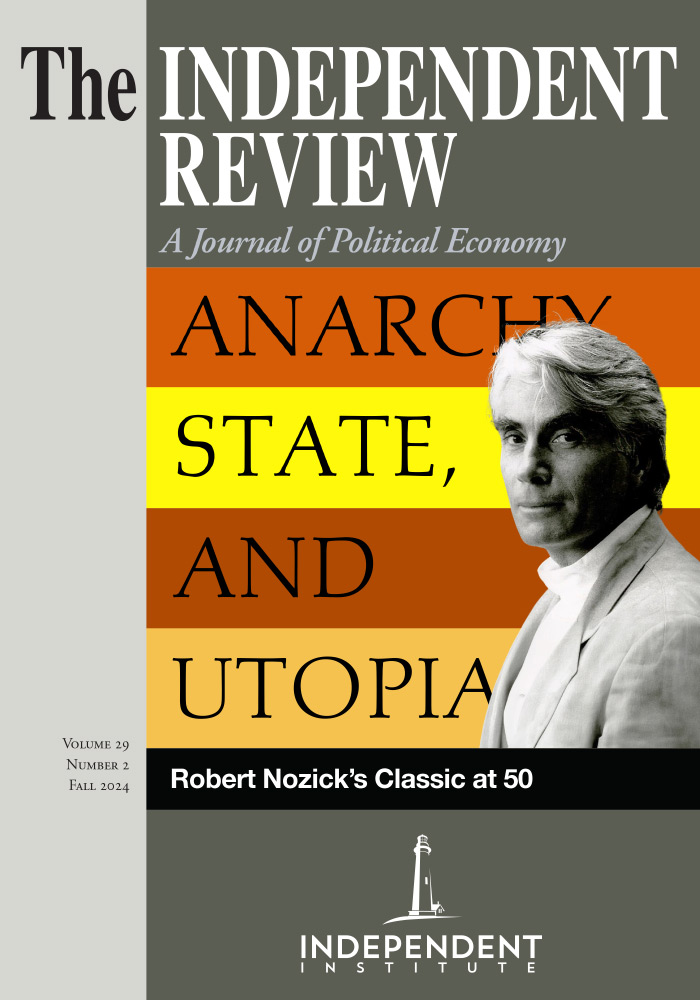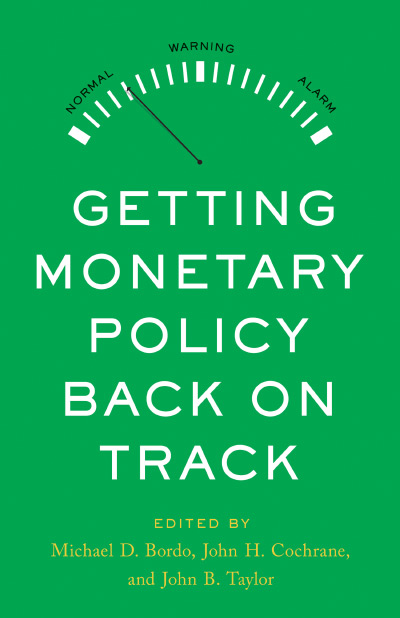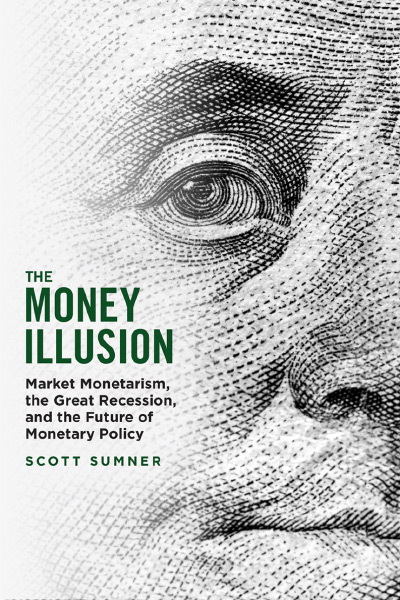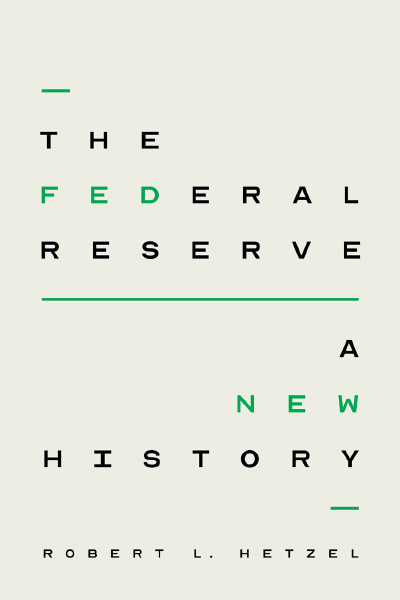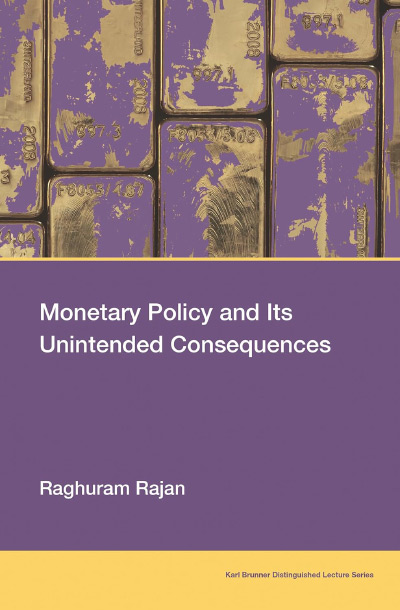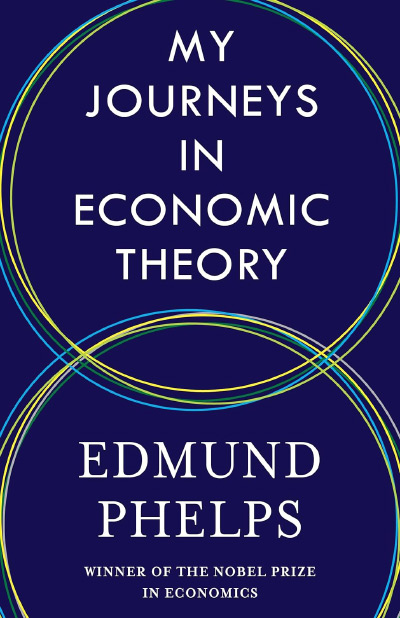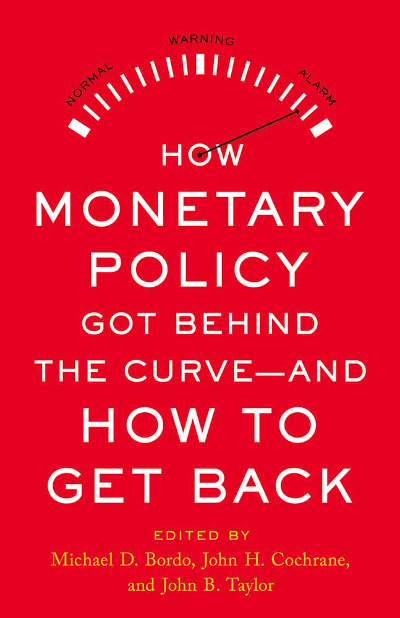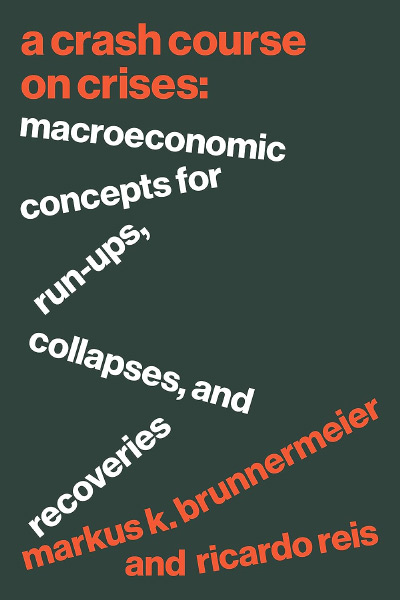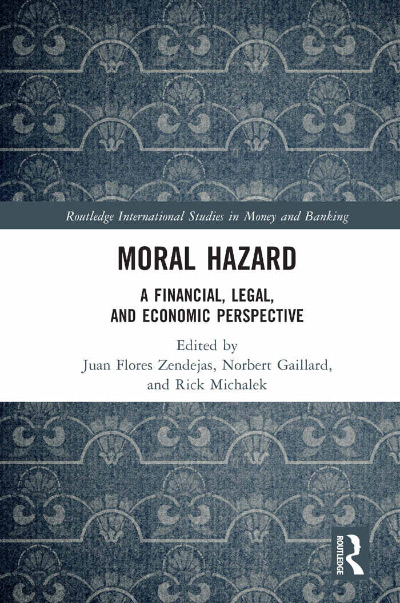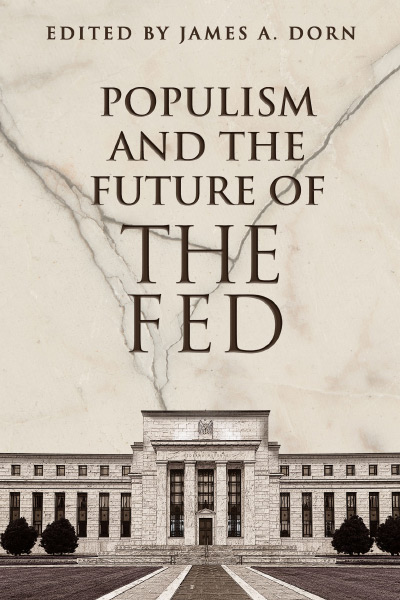Getting Monetary Policy Back on Track collects papers presented at the May 2023 Hoover Monetary Policy Conference, the latest in an annual series of events organized by John H. Cochrane and John B. Taylor’s Economic Policy Working Group at Stanford University’s Hoover Institution. Here, they are joined in their efforts by Hoover Fellow Michael D. Bordo.
At the time of the conference, the Federal Reserve was struggling—as it still is today—to restore price stability following 2021’s inflationary surge. From March 2022 through May 2023, the Fed raised its target for the federal funds rate by 5 full percentage points. And just a few months before the conference, the Silicon Valley Bank of Santa Clara, the Signature Bank of New York, and the First Republic Bank of San Francisco collapsed in rapid succession after experiencing severe losses triggered, at least in part, by those very same interest rate hikes.
The essays and speeches collected here cover a variety of topics, but most focus on these current events. Contributors include prominent academic and financial-market economists as well as current and former policymakers from the Fed and other central banks. While their analyses are necessarily somewhat technical, their arguments are presented clearly through a combination of words, tables, and graphs. References to more complex statistical and mathematical models are confined to footnotes that offer suggestions for further reading. The papers remain fully accessible, therefore, to all readers of The Independent Review. They will be of special interest to those who want to understand how and why so much has gone wrong with U.S. monetary and financial regulatory policies over the past several years.
Some readers will read the volume from cover to cover, reproducing the experience of the conference itself. For these readers, discussants’ comments and questions from the floor follow each paper. Other readers may pick and choose, based on their own particular interests. Accordingly, this review will briefly summarize each chapter individually, while highlighting the common themes that emerge along the way.
The volume opens with a set of papers celebrating the thirtieth anniversary of John Taylor’s famous monetary policy rule (1993, “Discretion versus Policy Rules in Practice,” Carnegie-Rochester Conference Series on Public Policy 39 [December]: 195–214). The Taylor rule provides a strikingly simple formula for adjusting the federal funds rate in response to movements in inflation and real GDP. As Taylor and others have shown over the past three decades, the rule does a remarkably good job of describing Federal Reserve policy during the late 1980s and 1990s—the period of low inflation with stable growth known to economists as the “Great Moderation.” It also describes optimal monetary policy across a wide range of macroeconomic models.
The authors of these first three papers are particularly well chosen. Former Fed vice chair Richard H. Clarida provides an insider’s detail on how the Taylor rule gets used for monetary policy evaluation at the Federal Reserve. John Lipsky likewise describes how, as chief economist at Salomon Brothers in the early to mid-1990s, he and his colleagues used the Taylor rule as the basis for their interest rate projections. And Volker Wieland summarizes the academic studies, alluded to above, that confirm the Taylor rule’s usefulness within state-of-the-art macroeconomic models.
The message from these three papers is clear. The Taylor rule provides a very useful benchmark for monetary policymakers. Using today’s rate of inflation and GDP, it prescribes a setting for the federal funds rate that is consistent with decisions made, under similar macroeconomic conditions, in the past. It thereby serves as a guide through which policy successes from the past can be repeated and major mistakes—like that from 2021—might be avoided.
The next three papers turn to the failure of Silicon Valley Bank. Darrell Duffie and former Federal Reserve vice chair for supervision Randal Quarles focus on the inadequacy of the elaborate regulatory framework constructed following the 2008 financial crisis in preventing the dramatic deposit outflows that precipitated SVB’s collapse. But both of these papers hint at a more important distinction highlighted in the third, by Amit Seru.
Seru emphasizes that neither SVB nor any of the other banks caught up in the crisis of early 2023 suffered from the classic “liquidity” problem that arises when depositors rush to withdraw funds from an otherwise healthy bank. Instead, SVB faced a “solvency problem.” Even before the deposit outflow, the value of its assets had declined to levels far below the value of its liabilities. SVB was bankrupted by poor investment decisions that failed to consider the possibility that interest rates would move as high as they did, and as quickly as they did, in 2022–23. Seru argues compellingly that even more complex regulations and detailed oversight are unlikely to prevent similar solvency crises from recurring. Instead, banks and other financial institutions should be required to finance themselves by issuing more equity and less debt. Seru’s simple rule—more equity, less debt—works for bank regulation in much the same way that the Taylor rule works for monetary policy. It eschews discretionary fine-tuning in order to avoid major mistakes.
The next two papers share a similar spirit, by using new data to address classic problems in macroeconomics. Anusha Chari and Peter Blair Henry assess the likely costs of reducing inflation in today’s U.S. by estimating the costs of previous disinflationary episodes in twenty-one developing economies. Instead of measuring these costs, as is most frequently done, in terms of lost output or employment, however, Chari and Henry make clever use of information in stock prices instead. Meanwhile, Niall Ferguson, Paul Schmelzing, Martin Kornejew, and Moritz Schularick weigh the costs and benefits of large-scale financial market interventions, like those pursued by the Fed in both 2008–9 and 2020, by assembling a remarkable new dataset on central bank balance sheets that extends back five centuries. In between these interesting and innovative papers, the volume presents the text of a lunchtime speech by former Bank of Japan governor Haruhiko Kuroda, who provides a useful synopsis of Japanese monetary policy from 2013 through 2023.
Mickey D. Levy’s paper stands, together with Seru’s, as the best of the bunch. In it, Levy enumerates the various factors that “contributed to the biggest monetary policy error and the highest inflation since the 1970s” and “to the sizable assetliability mismatch of commercial banks, a key source of the recent banking crisis” (p. 261). These factors include grossly inaccurate forecasts of inflation and interest rates and modeling errors that neglected the role of massive fiscal stimulus in reinforcing the inflationary thrust of the Fed’s own overexpansionary monetary policies. They also include errors stemming from a “circle the wagons mentality” (p. 280) that discouraged debate and discussion of alternative policy options even as inflation was accelerating markedly. And they include a strategic plan, adopted in 2020 but based on the Fed’s quite different experience following the 2008–9 recession, which was biased heavily toward creating the additional inflation that did, in fact, follow in 2021. Levy’s paper should be required reading for all Federal Reserve officials, especially as they prepare for another strategic review later this year.
Former St. Louis president James Bullard summarizes quite nicely the policy error that Levy describes in much more detail with skillful use of a single graph. His figure (p. 332) shows clearly how the Taylor rule began to prescribe rapid interest rate increases as early as June 2021. Monetary policy then fell further and further “behind the curve” as the Fed continued to hold rates at zero through March 2022. Bullard’s graph also helps support Federal Reserve vice chair Philip N. Jefferson’s claim, made in the paper that follows, that the series of interest rate hikes finally implemented by the Fed in 2022– 23 have brought monetary policy back in line with historical norms. Substantial damage, however, has already been done, through the high inflation that persists even today.
Two informative papers conclude the conference volume. In one, former Federal Reserve Bank presidents Jeffrey M. Lacker and Charles I. Plosser bring the conversation back full circle, with a set of arguments favoring a larger and more explicit role for the Taylor rule in the Fed’s policymaking and communications strategies. In the other, Sebastian Edwards brings readers up to date on economic developments in Latin America where, in several countries, more rulelike monetary policymaking has brought inflation down to levels at or even below that prevailing in the U.S.
Altogether, the papers collected in this volume can be read as a series of further case studies illustrating what the title of Taylor’s original 1993 article refers to as “discretion versus policy rules in practice.” Policymakers at the Fed have always rejected calls to make their decisions with consistent reference to simple rules like Taylor’s for monetary policy and Seru’s for bank regulation. In theory, their arguments seem compelling. Monetary and financial regulatory policymaking is, they say, much too important and complicated a task to trust to a simple rule. Expert judgment and discretion will always be essential for getting policies exactly right.
The problem is that, in practice, exactly the opposite appears to be true. As the papers in this volume make clear, discretion delivered the high inflation we suffer from now. And nothing in the complex regulatory apparatus put in place post-2008 worked to prevent the bank failures of 2023. Simply put: simple rules are needed to get policy back on track.

